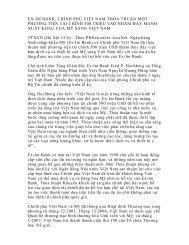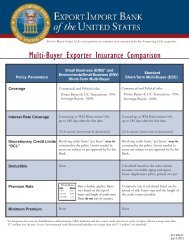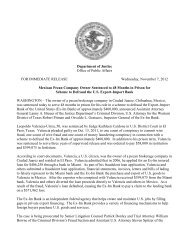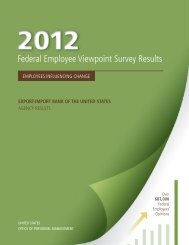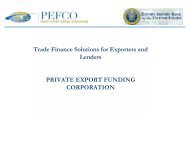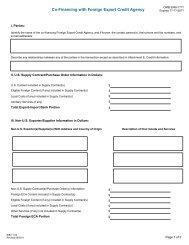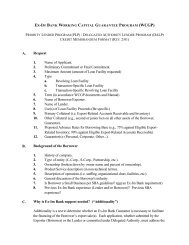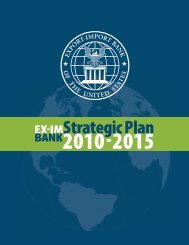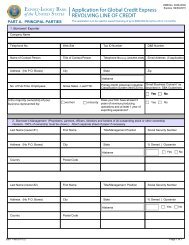2011 508 accessible version - Export-Import Bank of the United States
2011 508 accessible version - Export-Import Bank of the United States
2011 508 accessible version - Export-Import Bank of the United States
- No tags were found...
Create successful ePaper yourself
Turn your PDF publications into a flip-book with our unique Google optimized e-Paper software.
Chapter 3: Core Business Policies and PracticesSection C: Risk PremiaIntroductionTo cover <strong>the</strong> risk <strong>of</strong> non-payment for a transa ction, ECAs charge risk premia, o<strong>the</strong>rwiseknown as exposure fees. The 1999 Kn aepen Package implemented by <strong>the</strong> OE CDParticipants was negotiated to level th e playing fiel d among ECAs. The agreem entdefined <strong>the</strong> elements for determining sove reign buyer fees and set Minimum PremiumRates (MPRs) for transactions with sove reign buyers. The MPR sets <strong>the</strong> floor forstandard export credit pricing <strong>of</strong> sovereign buyers. Shortly after <strong>the</strong> Knaepen Packagewas implemented, <strong>the</strong> Participants embarked on negotiations to institute a buyer riskclassification and pricing system, as it wa s evident that ECA business wa s moving fromsovereign to non-sovereign buyers. The negoti ations continued for many years but withno success. After a two-year lapse, <strong>the</strong> OECD Participants reignited <strong>the</strong> negotiations inJune 2008. A new comprehensive fee structure, refer red to as t he Malzkuhn-DrysdalePackage was approved in Febru ary 2010 with an implementation date <strong>of</strong> September 1,<strong>2011</strong>.The Malzkuhn-Drysdale Pack age established a non-sovereign buyer fee system,including both guidance on risk classification as well as MPRs for non-sovereign buyers.It also updated <strong>the</strong> MPRs for sovereign bu yers and established pricing protocols fortransactions in high-income OECD and Eu ro-area countries (also known as Category 0markets).Several elements determine <strong>the</strong> MPR for both sovereign and non-sovereign buyers: ( i)<strong>the</strong> percentage <strong>of</strong> cover; (ii) <strong>the</strong> q uality <strong>of</strong> <strong>the</strong> product—that is, whe<strong>the</strong>r <strong>the</strong> financing isan unconditional guarantee or conditional insurance; and (iii) <strong>the</strong> claims paymentpolicy. The latter two factors determin e whe<strong>the</strong>r a product is considered “abovestandard”, “standard”, or “below standard.” 1 Because coverage may differ based on <strong>the</strong>sefactors, <strong>the</strong> three types <strong>of</strong> products are pric ed differently, with “above standard” bein g<strong>the</strong> most expensive and “below standard” <strong>the</strong> least expensive. These variations allow forsurcharges or discounts based on <strong>the</strong> typ e <strong>of</strong> product to ensure a level playing fieldamong ECAs. In addition, surcharges and di scounts are applied when <strong>the</strong> cover differsfrom <strong>the</strong> typical 95% level <strong>of</strong> coverage. For example, for 100% cover, <strong>the</strong>re is a surchargebetween 5.3% and 14.3% depending on <strong>the</strong> country’s risk level; and for 90% cover, <strong>the</strong>reis a discount <strong>of</strong> 5.4%.Under <strong>the</strong> Malzkuhn-Drysdale Package <strong>the</strong>re are now 7 categories <strong>of</strong> buyer risk in whichobligors may be classi fied: better than so vereign, sovereign or equ al to sovereign and 5buyer risk categories riskier than <strong>the</strong> sovere ign classification. The riskier th e buyer, <strong>the</strong>1 Above Standard Product – i.e. guarantees; Standard Product – i.e. insurance with cover <strong>of</strong> interestduring <strong>the</strong> claims waiting period without an appropriate premium surcharge and direct credit/financing;and Below Standard Product – i.e. insurance without cover <strong>of</strong> interest during <strong>the</strong> claims waiting periodand insurance with cover <strong>of</strong> interest during <strong>the</strong> claims waiting period with an appropriate premiumsurcharge.33







